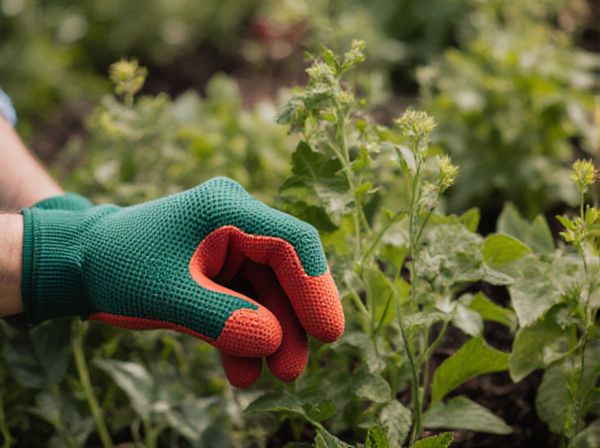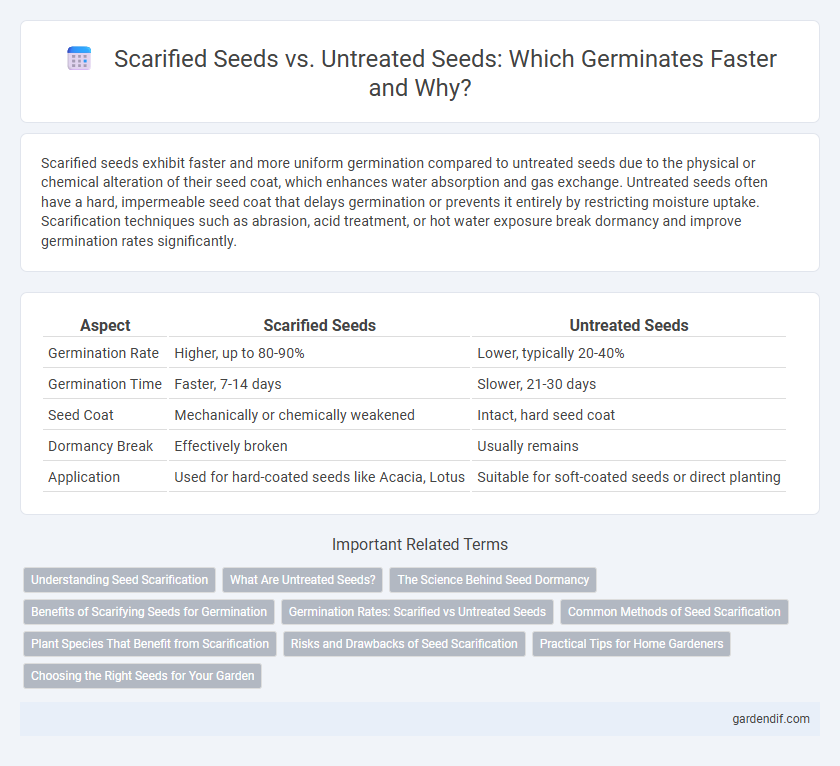
Scarified Seeds vs Untreated Seeds Illustration
Scarified seeds exhibit faster and more uniform germination compared to untreated seeds due to the physical or chemical alteration of their seed coat, which enhances water absorption and gas exchange. Untreated seeds often have a hard, impermeable seed coat that delays germination or prevents it entirely by restricting moisture uptake. Scarification techniques such as abrasion, acid treatment, or hot water exposure break dormancy and improve germination rates significantly.
Table of Comparison
| Aspect | Scarified Seeds | Untreated Seeds |
|---|---|---|
| Germination Rate | Higher, up to 80-90% | Lower, typically 20-40% |
| Germination Time | Faster, 7-14 days | Slower, 21-30 days |
| Seed Coat | Mechanically or chemically weakened | Intact, hard seed coat |
| Dormancy Break | Effectively broken | Usually remains |
| Application | Used for hard-coated seeds like Acacia, Lotus | Suitable for soft-coated seeds or direct planting |
Understanding Seed Scarification
Scarified seeds undergo intentional physical or chemical treatment to weaken the seed coat, promoting faster water absorption and germination. Untreated seeds often exhibit slower germination rates due to intact seed coats that act as natural barriers to moisture and oxygen. Understanding seed scarification techniques, such as mechanical abrasion or acid treatment, is essential for improving germination success in species with hard seed coats.
What Are Untreated Seeds?
Untreated seeds are seeds that have not undergone any physical or chemical modifications to break dormancy and promote faster germination. These seeds rely solely on natural environmental factors like temperature, moisture, and time to initiate sprouting. Germination rates and success in untreated seeds are typically slower and less uniform compared to scarified seeds, which are mechanically or chemically treated to enhance seed coat permeability.
The Science Behind Seed Dormancy
Scarified seeds break through tough seed coats by mechanically or chemically weakening the outer layer, allowing water and gases to penetrate and trigger germination processes critical for overcoming seed dormancy. Untreated seeds often remain dormant due to impermeable seed coats that prevent water absorption and gas exchange, effectively inhibiting the metabolic activities necessary for sprouting. Seed dormancy regulation involves complex hormonal signaling, primarily abscisic acid maintaining dormancy and gibberellins promoting germination once physical barriers like seed coats are disrupted through scarification.
Benefits of Scarifying Seeds for Germination
Scarifying seeds significantly enhances germination rates by breaking the hard seed coat, allowing water and oxygen to penetrate more effectively. This mechanical or chemical process accelerates germination time and promotes uniform seedling emergence. Compared to untreated seeds, scarified seeds show higher vigor and improved seedling development due to better resource absorption.
Germination Rates: Scarified vs Untreated Seeds
Scarified seeds exhibit significantly higher germination rates compared to untreated seeds due to the physical or chemical treatment breaking seed coat dormancy, allowing for faster water absorption and embryo expansion. Studies show scarified seeds can achieve germination rates up to 90%, whereas untreated seeds often remain below 40% due to impermeable seed coats. This enhanced germination success improves seedling establishment in both agricultural and ecological restoration projects.
Common Methods of Seed Scarification
Common methods of seed scarification include mechanical, chemical, and thermal techniques that enhance water absorption and germination rates. Mechanical scarification involves physically breaking or weakening the seed coat using tools like sandpaper or knives, while chemical scarification uses acids or alkalis to dissolve seed coats. Thermal scarification applies heat through hot water or dry treatments to soften tough seed coats, significantly improving germination success compared to untreated seeds.
Plant Species That Benefit from Scarification
Plant species such as red clover, sweet pea, and certain acacia varieties benefit significantly from scarification, which breaks down their hard seed coats to enhance water absorption and germination rates. Untreated seeds of these species often exhibit delayed or low germination due to impermeable seed coats that inhibit moisture uptake. Scarification techniques, including mechanical abrasion, acid treatment, or hot water soaking, improve germination speed and uniformity in these otherwise dormant seeds.
Risks and Drawbacks of Seed Scarification
Seed scarification enhances germination by weakening the seed coat but carries risks such as damaging the embryo if done improperly. Untreated seeds avoid physical injury but often exhibit lower and slower germination rates. Excessive scarification can lead to fungal infections and reduced seed viability, impacting overall crop success.
Practical Tips for Home Gardeners
Scarified seeds, which have had their hard outer coating deliberately scratched or nicked, absorb water more efficiently and germinate faster compared to untreated seeds. Home gardeners can improve germination rates by gently rubbing seeds with sandpaper or soaking them overnight in warm water before planting. Treating seeds in this way is especially beneficial for tough-coated species like morning glory, sweet pea, and many tree seeds, leading to higher sprout success in home gardens.
Choosing the Right Seeds for Your Garden
Scarified seeds demonstrate significantly higher germination rates compared to untreated seeds due to their enhanced ability to absorb water and oxygen. Choosing scarified seeds can lead to faster, more uniform sprouting, especially for hard-coated varieties like morning glory or sweet peas. Prioritizing scarified seeds in your garden boosts seedling vigor and improves overall crop success.
Scarified Seeds vs Untreated Seeds Infographic

 gardendif.com
gardendif.com